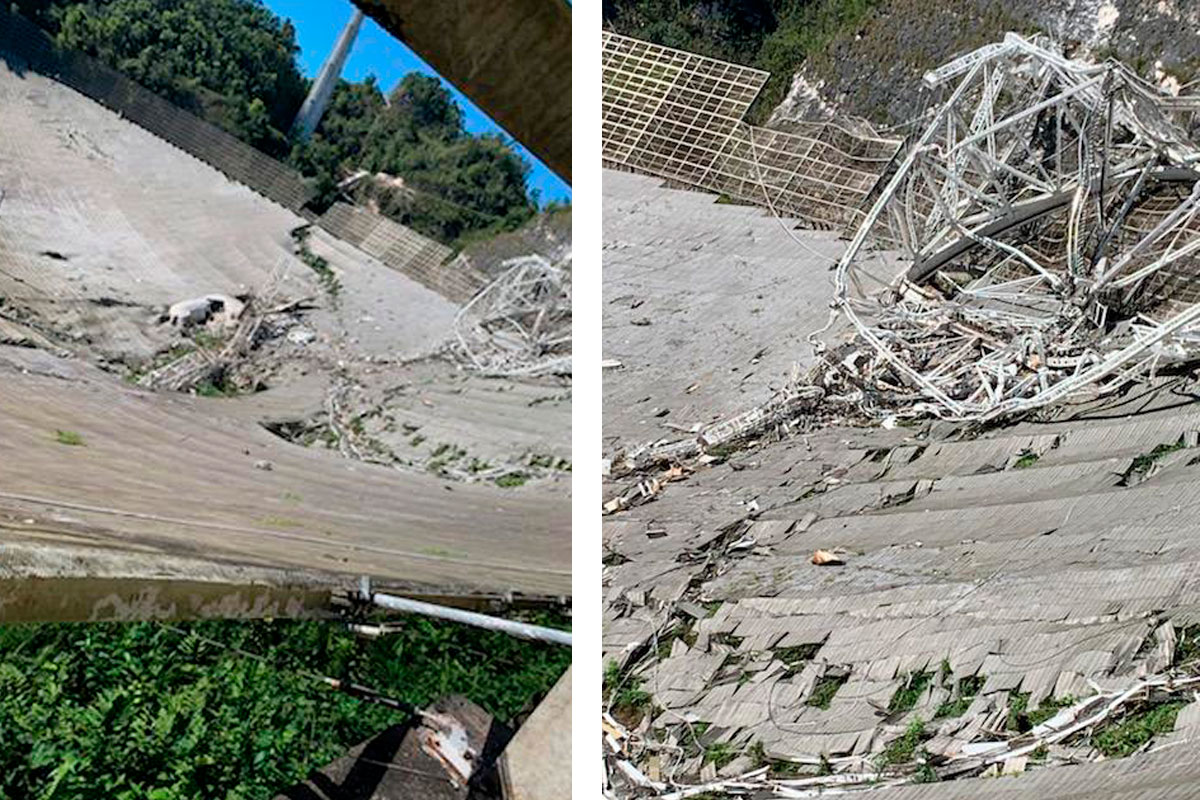The Arecibo Observatory radio telescope in Puerto Rico has collapsed
The hanging structure crashed through Arecibo's radio dish after major cable failures.

After two cable failures in the span of four months, Puerto Rico's most venerable astronomy facility, the Arecibo radio telescope, has collapsed in an uncontrolled structural failure.
The U.S. National Science Foundation (NSF), which owns the site, decided in November to proceed with decommissioning the telescope in response to the damage, which engineers deemed too severe to stabilize without risking lives. But the NSF needed time to come up with a plan for how to safely demolish the telescope in a controlled manner.
Instead, gravity did the job this morning (Dec. 1) at about 8 a.m. local time, according to reports from the area.
"NSF is saddened by this development," the agency wrote in a tweet. "As we move forward, we will be looking for ways to assist the scientific community and maintain our strong relationship with the people of Puerto Rico."
The NSF added that no injuries had been reported, that the top priority was to maintain safety and that more details would be provided when confirmed.
Related: Losing Arecibo Observatory creates a science hole that can't be filled
"What a sad day for Astronomy and Planetary science worldwide and one of the most iconic telescopes of all time," Thomas Zurbuchen, NASA's associate administrator for science, wrote in a tweet. "My thoughts are with the staff members and scientists who have continued to do great science during the past years and whose life is directly affected by this."
Get the Space.com Newsletter
Breaking space news, the latest updates on rocket launches, skywatching events and more!
Images shared on Twitter by Deborah Martorell, a meteorologist for Puerto Rican television stations, compare views of the observatory taken yesterday — showing the 900-ton science platform suspended over the massive dish strung up on cables — and today, when the observatory's three supporting towers are bare.
Ayer fue la última vez que visite esta belleza de lugar. Lamentablemente agonizaba. Aquí imágenes de ayer y hoy. pic.twitter.com/jWuAwtUc1sDecember 1, 2020
None of the three towers collapsed fully, which was one of NSF's key concerns about leaving the structure as it was. Martorell's image does appear to show some damage in the knot of buildings at the base of one of the support towers, which includes administrative buildings and a public visitor's center, although the buildings are still standing.
In an interview with local television station Noticentro, Jonathan Friedman, a physicist who works at Arecibo Observatory and lives nearby, said that he heard a loud rumble that he compared to a train or an avalanche — or to the earthquakes that plagued Puerto Rico in January. Friedman also confirmed that only the tips of the supporting towers broke off, as Martorell's image suggested.

Since the first cable failure in August, Arecibo Observatory has enforced a safety zone at the facility, although its size changed as damage was incurred and evaluated, Ralph Gaume, director of NSF's Division of Astronomical Sciences, said during a news conference held on Nov. 19, at which the NSF announced its decision to decommission the telescope.
Even during that news conference, the tenuous state of the telescope was clear. "The structure, as far as I know, is currently standing, so that implies that it is currently stable," Gaume said at the time, while also noting the 2.5-month gap between the first cable failure and the second.
The massive radio dish has been at the forefront of atmospheric science, radio astronomy, and planetary radar capability for decades. It was also the unusual telescope to become an icon in popular culture, thanks in part to its leading roles in the movies GoldenEye and Contact.
In addition to the telescope, Arecibo Observatory also includes a LIDAR instrument that scientists use to study the area where Earth's atmosphere and space meet. When the NSF announced that it would decommission the telescope, officials emphasized that a key priority was ensuring Arecibo Observatory as a larger facility would continue.
At the time, the NSF couldn't assess whether the telescope would be replaced.
"This is a really, really hard morning for Puerto Rico, for science, for our connection to the cosmos," journalist Nadia Drake, whose father Frank Drake is a former director of Arecibo Observatory, wrote in a tweet. "RIP #Arecibo."
Editor's note: The story was updated at 9:15 a.m. to include a statement from the NSF. Email Meghan Bartels at mbartels@space.com or follow her on Twitter @meghanbartels. Follow us on Twitter @Spacedotcom and on Facebook.
Join our Space Forums to keep talking space on the latest missions, night sky and more! And if you have a news tip, correction or comment, let us know at: community@space.com.

Meghan is a senior writer at Space.com and has more than five years' experience as a science journalist based in New York City. She joined Space.com in July 2018, with previous writing published in outlets including Newsweek and Audubon. Meghan earned an MA in science journalism from New York University and a BA in classics from Georgetown University, and in her free time she enjoys reading and visiting museums. Follow her on Twitter at @meghanbartels.









